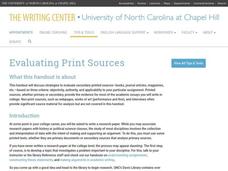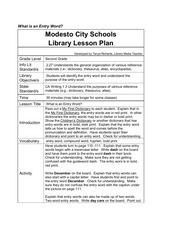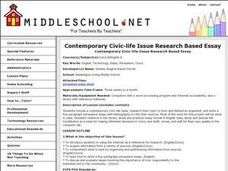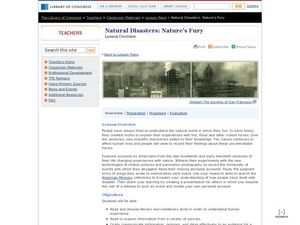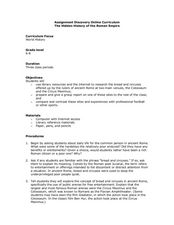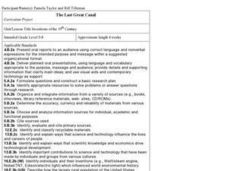Curated OER
Catch-22
During or after reading Catch-22, have your high school scholars complete this research project. First they'll brainstorm a list of people they might like to research, then they'll dive into your library's resources! There are...
Curated OER
Choosing the Lincoln Statue
Fourth graders research photographs or artwork depicting Abraham Lincoln during the time when he was traveling the 8th Judicial Circuit and practicing law in Champaign County. They develop a Powerpoint presentation of the results of the...
Curated OER
George Washington: First in War, First in Peace, and First in the Hearts of His Countrymen
Students interpret historical evidence presented in primary and secondary resources. In this George Washington activity, students research the details of Washington's military successes, his role at the Constitutional Convention, and...
Curated OER
Immigration History Firsthand
Middle schoolers interpret historical evidence presented in primary and secondary resources. In this immigration lesson, students conduct research regarding Ellis Island and the American immigrant experience. Middle...
Curated OER
Sports Participation
Students research statistics about sports participation in references such as the Statistical Abstract of the United States. They make and analyze a list of the 10 sports that the highest number of Americans participated in on an amateur...
Curated OER
The Grapes of Wrath: Scrapbooks and Artifacts
Students interpret historical evidence presented in primary and secondary sources. For this Great Depression lesson, students read John Steinbeck's The Grapes of Wrath and use ethnographic research...
Curated OER
Suffrage Strategies: Voices for Votes
Students discuss the history and importance of voting. In this voting lesson, students research the women's suffrage movement and the methods used to change people's beliefs about suffrage for women. Students also create posters to...
Curated OER
Waldseemuller's Map: World 1507
Students investigate the 1507 word map. In this world geography lesson, students examine the details of each section of the map and then draw conclusions about how the people of 1507 understood the world. Students are evalated on...
Facing History and Ourselves
Exploring Raphael Lemkin's Actions: The Invention of the Word "Genocide"
Learners examine the contributions of Raphael Lemkin. For this genocide activity, high schoolers consider how Lemkin defined the atrocities of the Holocaust as he coined the term "genocide." Learners discuss the definition of genocide as...
Curated OER
So Sweet
Students compare sugar levels in cereals. In this nutrition lesson, students learn how to read a nutrition facts label, predict which products will have the most sugar, discover which cereals contain the most sugar and discuss...
Facing History and Ourselves
What is Community?
Sixth graders contrast communities with groups. In this community lesson, 6th graders read "What is Community?" and discuss attributes of communities that distinguish them from groups.
Brigham Young University
Understanding the Research Process
The second lesson in a unit on set design focuses on the importance of historical and stylistic research. Working in teams created in the previous session, groups consider what resources they will use as they consider design concepts for...
University of North Carolina
Evaluating Print Sources
Not all sources are created equal, so how do you evaluate them? Writers learn how to evaluate print sources based on elements such as audience, tone, and argument in the sixth handout of 24 in the Writing the Paper series from the...
Curated OER
Art: Weaving Based on Draft Patterns
Fourth graders observe the process of drafting a pattern on graph paper. After creating their own patterns, they create their own weavings, and explain its title to the class.
Facing History and Ourselves
Analyzing Historical Evidence
High schoolers examine World War I war crimes. In this world history instructional activity, students use primary and secondary sources to research and understand the systematic nature of the Armenian Genocide. High schoolers reflect on...
Curated OER
Be That As It Maya
Creative projects are a great way to engage your class and can be a fun way to assess mastery! Learners create brochures and postcards that might have been created by and for travelers to ancient Mayan cities. They read and discuss the...
Curated OER
Dictionary Work - Entry Words
Second graders examine the use of entry words in the dictionary. In this dictionary use lesson, learners look at guide words in a children's dictionary as the teacher/librarian describes the characteristics of each entry. They complete...
Curated OER
Creating Context Mural
students examine the historical, political, religious and culture aspects of the Renaissance. Using this information, they read "Galileo" by Bertolt Brecht. They use the internet to research a specific event of the time period and come...
Curated OER
Contemporary Civic-life Issue Research Based Essay
Seventh graders write a five paragraph persuasive essay on a contemporary civic-life issue.
Curated OER
Measuring Activities
Students measure using both metric and standard measures. They convert from one standard to the next while measuring distances in their home or classroom.
Curated OER
Natural Disasters: Nature's Fury
Pupils explore the human experience. In this business ethics instructional activity, students analyze primary sources to develop an understanding of the American natural disasters of the 19th and 20th centuries and the implications they...
Curated OER
The Hidden History of the Roman Empire
Students compare entertainment in ancient Rome to entertainment today. In this ancient Rome lesson, students research the details regarding the entertainment that occurred in the Colosseum and the Circus Maximus in Rome. Students compare...
Curated OER
L I V I N G U N D E R C O M M U N I S M
Learners examine a communist regime and what it means to live within a communist societyl.
Curated OER
Inventions of the 19th Century
Students explore inventions that have been created since the nineteenth century.












